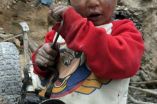(Press-News.org) Scientists have discovered new evidence about the evolution of viruses, in work that will change our understanding about the control of infectious diseases such as winter flu.
Researchers at the University of Exeter's conducted experiments to manipulate a virus to see if it could evolve the ability to switch its behaviour according to how many other viruses infect a host.
Previous research has focussed on trying to force harmful microbes to become less threatening to human health as they evolve. But the new research, which was carried out in collaboration with the University of Oxford, proves viruses can readily develop the ability to adjust their behaviour to maximise their spread, in response to whether they are infecting as a single entity or in combination with other viruses.
Helen Leggett, a postgraduate researcher at the University of Exeter, was the lead scientist on the work, which is published online on December 13th in the journal Current Biology. She said: "Scientists are constantly searching for ways to limit the damage viruses can cause, to help reduce the impact of illnesses like winter flu and to respond to the next pandemic. Our work proves that regardless of how we try to manipulate viruses, they will always switch their behaviour to serve their own purposes and kill as many cells as possible. This study involved a relatively simple virus. If it can evolve so quickly, it's reasonable to assume that a lot of other viruses and parasites can, too."
The study was funded by the European Research Council, the Leverhulme Trust and the Natural Environment Research Council, while Helen Leggett is supported by the Biotechnology and Biological Sciences Research Council. The work also shed light on why organisms cooperate with each other. The virus would only cooperate with viruses which were related to it. When it infected alone it would clone itself within the cell, and would cooperate with those new viruses. In this context, cooperation meant killing the host relatively slowly so that the virus could replicate more. But when it interacted with other viruses which were not related, it killed the cell faster, allowing it to out-replicate and dominate the other viruses.
### END
Viruses cooperate or conquer to cause maximum destruction
Scientists have discovered new evidence about the evolution of viruses, in work that will change our understanding about the control of infectious diseases such as winter flu
2012-12-13
ELSE PRESS RELEASES FROM THIS DATE:
Millions of patients still waiting for medical 'breakthroughs' against neglected diseases
2012-12-13
New York, NY, December 13, 2012— Despite important progress in research and development (R&D) for global health over the past decade, only a small fraction of new medicines developed between 2000 and 2011 were for the treatment of neglected diseases, highlighting the 'fatal imbalance' between global disease burden and drug development for some of the world most devastating illnesses, said Doctors Without Borders/Médecins Sans Frontières (MSF) and the Drugs for Neglected Diseases initiative (DNDi), in an analysis to be presented today at an international conference aimed ...
23andMe's Ancestry Composition reveals people's ancestral origins going back 500+ years
2012-12-13
Mountain View, Calif. – December 13, 2012 -- 23andMe, the leading personal genetics company, today announced the availability of Ancestry Composition, a new feature that provides state-of-the-art geographic illustration of an individual's ancestral origins. Using 22 reference populations, the feature indicates what percent of a person's ancestry comes from various regions around the world. The analysis includes DNA inherited from all ancestors on both sides of the family. The results reflect where an individual's ancestors lived going back approximately 500 years.
Ancestry ...
A finding that could help Alpha-1 sufferers breathe more easily
2012-12-13
Scientists have identified a new mutation in the gene that causes the inherited disease known as Alpha-1 Antitrypsin Deficiency (Alpha-1), which affects roughly one in 2,500 people of European descent.
Alpha-1 can lead to serious lung disease in adults, or liver disease at any age.
The finding extends understanding of Alpha-1 at the molecular level, potentially leading to new drug development and better diagnostic tools.
Dr Darren Saunders from Sydney's Garvan Institute of Medical Research and Professor Vanessa Hayes, from the J. Craig Venter Institute in San Diego, ...
Moving pictures: Optical entertainments and the advent of cinema
2012-12-13
Primary sources publisher, Adam Matthew, has announced the release of the fourth section of its highly renowned Victorian Popular Culture Portal. "Moving Pictures, Optical Entertainments and the Advent of Cinema" explores the cultural history of optical entertainments from the late 18th century to the early 20th century, bringing to life the rich cultural and scientific history from which cinema was born.
From shadow puppets to dioramas, and from zoetropes to Hollywood, the long and varied evolution of visual entertainments is represented through objects, ephemera and ...
Disaster map predicts bleak future for mammals
2012-12-13
MAMMALS could be at a greater risk of extinction due to predicted increases in extreme weather conditions, states a paper published today by the Zoological Society of London (ZSL).
Scientists have mapped out land mammal populations, and overlapped this with information of where droughts and cyclones are most likely to occur. This allowed them to identify species at high risk of exposure to extreme weather. The paper, published this week in the journal Conservation Letters, describes the results of assessing almost six thousand species of land mammals in this way.
Lead ...
Dolphin hearing system component found in insects
2012-12-13
A hearing system component thought to be unique in toothed whales like dolphins has been discovered in insects, following research involving the University of Strathclyde.
The research is challenging ideas about how a large group of insects including crickets and katydids hear, revealing the unexpected similarity to toothed whale hearing.
Scientists from the School of Biological Sciences at The University of Auckland, with colleagues from Plant & Food Research in New Zealand, led the research with engineers from the University of Strathclyde working on the biomechanical ...
Common anesthetic agents can be harmful for the development of the fetus
2012-12-13
An anesthetic regimen typically used during surgery on pregnant mothers appears to have a negative effect on the development of the fetus, according to a new study on mice conducted by neurobiologists from the National Center for Toxicological Research, in Arizona.
In the article 'Inhalation Anesthesia-Induced Neuronal Damage and Gene Expression Changes in Developing Rat Brain' published earlier this month in Systems Pharmacology, an open access journal by Versita – Dr. Fang Liu and Dr. Cheng Wang describe the effect of major, commonly used anesthetic compounds – Nitrous ...
Scientists develop novel method to study parasite numbers in wild seabirds
2012-12-13
Scientists have developed a new method for studying parasite numbers in the stomachs of individual seabirds in the wild. The technique enables the recording of video footage of worms inside seabird stomachs and is an important step forward in understanding the impact of parasites on seabird populations. The research is published today (13 December 2012) in the scientific journal Methods in Ecology and Evolution.
The research team trialled the use of endoscopy, often used in human and veterinary medicine but rarely in field situations, to measure natural parasite loads, ...
Confirmation that studying and child labor are incompatible
2012-12-13
Labour conditions, the amount of hours and working during the morning are the factors that most negatively affect the academic development of children who work. Using data from the 'Edúcame primero Colombia' Project ('Educate me first Colombia' in Spanish), a group of researchers in which the University of Seville participates has confirmed the incompatibility between studying and child labour.
The International Labour Organisation states that, in 2010, approximately 215 million children across the world were working. This figure has been progressively decreasing in ...
More than 200 genes identified for Crohn's Disease
2012-12-13
More than two hundred gene locations have now been identified for the chronic bowel condition Crohn's Disease, in a study that analysed the entire human genome.
Published today in The American Journal of Human Genetics, scientists at UCL have devised a new method for identifying and mapping gene locations for complex inherited diseases. Using this method, they have been able to identify a large number of additional genes for Crohn's Disease, making a total of more than 200, which is more than have been found for any other disease. For example, there are just 66 known ...
LAST 30 PRESS RELEASES:
Sports injuries sustained during your period might be more severe
World's first successful 2 Tbit/s free-space optical communication using small optical terminals mountable on satellites and HAPS
Can intimate relationships affect your heart? New study says ‘yes’
Scalable and healable gradient textiles for multi‑scenario radiative cooling via bicomponent blow spinning
Research shows informed traders never let a good climate crisis go to waste
Intelligent XGBoost framework enhances asphalt pavement skid resistance assessment
Dual-function biomaterials for postoperative osteosarcoma: Tumor suppression and bone regeneration
New framework reveals where transport emissions concentrate in Singapore
NTP-enhanced lattice oxygen activation in Ce-Co catalysts for low-temperature soot combustion
Synergistic interface engineering in Cu-Zn-Ce catalysts for efficient CO2 hydrogenation to methanol
COVID-19 leaves a lasting mark on the human brain
Scientists use ultrasound to soften and treat cancer tumors without damaging healthy tissue
Community swimming program for Black youth boosts skills, sense of belonging, study finds
Specific depressive symptoms in midlife linked to increased dementia risk
An ‘illuminating’ design sheds light on cholesterol
Who is more likely to get long COVID?
Study showcases resilience and rapid growth of “living rocks”
Naval Research Lab diver earns Office of Naval Research 2025 Sailor of the Year
New Mayo-led study establishes practical definition for rapidly progressive dementia
Fossil fuel industry’s “climate false solutions” reinforce its power and aggravate environmental injustice
Researchers reveal bias in a widely used measure of algorithm performance
Alcohol causes cancer. A study from IOCB Prague confirms damage to DNA and shows how cells defend against it
Hidden viruses in wastewater treatment may shape public health risks, study finds
Unlock the power of nature: how biomass can transform climate mitigation
Biochar reshapes hidden soil microbes that capture carbon dioxide in farmland
Reducing saturated fat intake shows mortality benefit, but only in high-risk individuals
Manta rays create mobile ecosystems, study finds
Study: Mixed results in using lipoic acid to treat progressive multiple sclerosis
Norbert Holtkamp appointed director of Fermi National Accelerator Laboratory
New agentic AI platform accelerates advanced optics design
[Press-News.org] Viruses cooperate or conquer to cause maximum destructionScientists have discovered new evidence about the evolution of viruses, in work that will change our understanding about the control of infectious diseases such as winter flu


